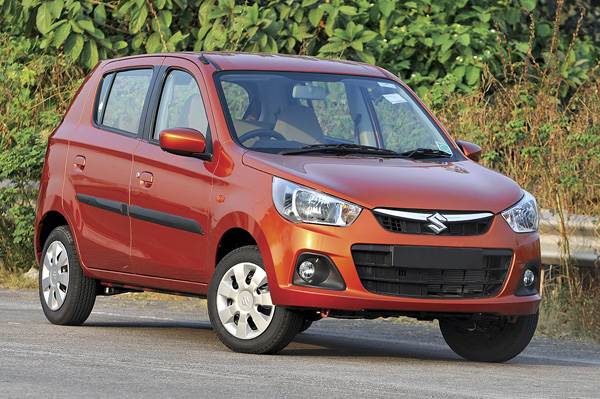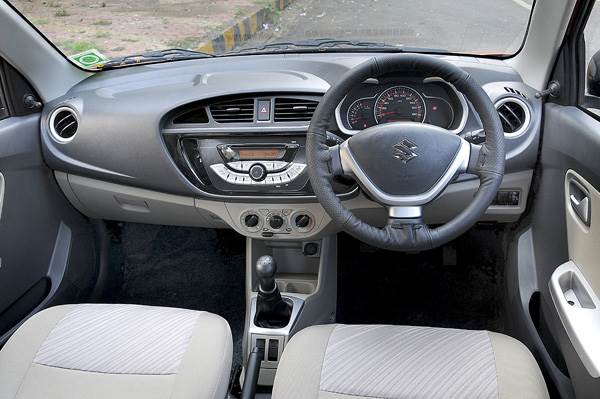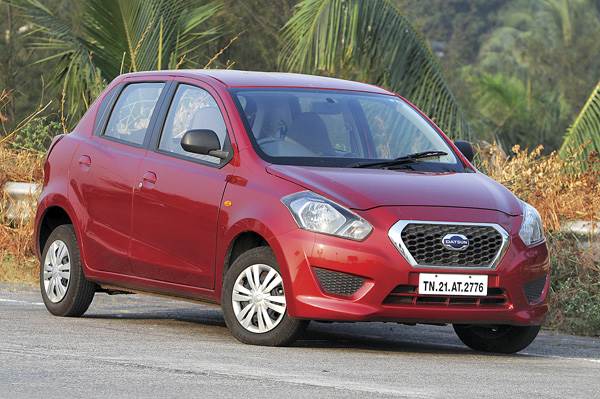What’s new?
When maruti launched the more powerful Alto K10 in 2009, the peppy little performer had no real rivals. Using basically a Maruti Swift petrol engine with one less cylinder, it was fast, fun and quite unique. The new Alto K10 comes into a slightly more crowded market this time around. Already in the market are the 67bhp Eon 1.0 and the 68bhp Datsun Go. Now, Maruti has finally launched the heavily upgraded K10 and at first glance, it looks like it was well worth the wait. The more rounded design looks attractive and the cabin design and material quality seem to have taken a huge leap forward. The competition, however, is quite stiff. The Hyundai Eon, for example, got a much needed boost in the form of a much more powerful and efficient 1.0-litre engine. That it looks and feels more premium than the others just adds to its value quotient. Datsun, on the other hand, set about its journey in India by redefining the entry budget car segment in India. Its advantage lies in the fact that the Go is a size bigger than the other two and has a larger 1.2-litre heart.
What are they like drive?
While All three cars here make within 1bhp of each other, the way they perform on the road are quite different. The Alto K10 has decent power at low engine speeds. The motor is responsive and quiet enough till 3,000rpm too. Part-throttle responses are good, and overtaking doesn’t take too much effort either. The gearbox also feels quite precise and you rarely miss a slot. Like all K-series engines, this motor also loves to be revved, but this considerably increases the noise levels. The engine sounds increasingly harsh when you approach its 6,100rpm rev limiter, and it’s best to shift up at around 4,500rpm. Still, the Alto K10 manages to reach 100kph in 15.46 seconds, which is plenty quick for a car of this price. Like the Alto K10, the Hyundai Eon 1.0-litre is powered by a 998cc three-cylinder engine. Compared to the Alto, engine idle is a lot smoother and overall refinement is the best over here. This engine makes an even bigger impression once you ease off the clutch and get moving. There’s none of that low-rpm jerkiness of the Alto and power delivery is crisp and it pulls well too. It’s not as peppy as the Datsun Go, but it’s more than up to the job of comfortably propelling the Eon to speed. A light clutch and reasonably smooth-shifting five-speed gearbox round this off as a car well suited to urban driving. Performance is better than the Alto with the Eon taking 15.01 seconds to reach 100kph. Fire up the Go and you will be surprised by the smoothness this three-pot unit offers. Compared to the Alto, which is also a three-cylinder engine, the Go’s motor is much smoother and the idle is as quiet as a four-cylinder unit. Depress the light clutch, slot the gearlever into first with a positive click, pat the throttle and the Go gives you little cause to complain. Throttle response at low revs is surprisingly good – we found ourselves comfortably driving in fifth gear at speeds as low as 50kph and these strong responses are mainly down to the larger 1.2-litre engine size. The best way to drive this car is to keep the engine spinning at low to moderate engine speeds, as after 4,500rpm, the engine starts to get a bit gruff. The Go managed to post the fastest times in this test with a figure of 14.54 seconds to reach 100kph. In-gear times are quite impressive too.

What are they like inside?
On the inside, the Alto K10’s dashboard is completely new. The design is curvy, the dials look upmarket and are easy to read. The vibrant seat fabric is modern and that lifts the cabin’s overall ambience. Despite these changes, the Alto K10’s cabin still doesn’t have the same air of quality that the Hyundai Eon displays. You sit pretty low in the Alto and due to the low stance of the car, getting in and out needs you to bend a lot. The front seat itself is comfortable but lacks enough under-thigh support. Seat bolstering is also not the best and you tend to get thrown around on enthusiastic drives. Although Maruti has tried to carve out more knee room for rear passengers with slim front seats, it’s still cramped, and headroom isn’t good either. Storage spaces aren’t abundant but the big cubby and bottle holder ahead of the gearlever are quite good, and the shelf above the glovebox is pretty useful too.

Slip past the Eon’s wide-opening front door and you’ll be convinced you’ve got more than your money’s worth. The quality of plastics is good enough to belong on the bigger and pricier i10. Fit and finish are impressive for a budget car and there is nothing visibly low-rent about the cabin; except for the old-fashioned door locks on top of the sill. This is a thoroughly modern interior and the beige plastics on the lower portion of the cabin enhance the upmarket feeling. The dashboard itself is smartly styled too, with the centre console following the hexagonal theme of the Eon’s frontal styling. The dull silver trim also adds a touch of class here. The simple instruments that include a speedometer, fuel gauge and temperature gauge (there’s no rev counter) are easy to read on the move. A small digital readout also indicates ideal gears for best fuel economy. Drivers will appreciate the good visibility out the front and finding a good driving position is simple, made easier still by the tilt-adjust steering. Back support from the slender, single-piece front seats is also quite good, but their tapering shape means your shoulders are left unsupported, and the fixed headrests are a tad short too. Space at the back is comparable to the Alto but is slightly less than in the Go. Rear knee room is adequate so long as the front occupant doesn’t push his seat all the way back. But headroom is not great and the narrow rear windows make the Eon feel smaller than it is in the back. Passengers in the rear will also have to make do with a slightly short seat squab and limited width. Boot space, at 215 litres however, is quite good for a car of this size. You can even fold the rear seats when more space is needed. Moving on to the third contender, the Go’s cabin is the most spacious but it feels cheap compared to the other two. The shiny, hard dashboard plastics are poor and even the grain is not what you’d expect on a car of this class. However, the deep glovebox, four cupholders and the storage recesses on the dashboard top all come together to make the interiors of the Go practical. But on the downside, there are no covers to any of these storage spaces. The back seat of the Go is the best in this test with ample support. But the large front bench makes you feel claustrophobic in the back. The Datsun has the biggest boot too and the low loading lip makes loading luggage very easy.
Ride and handling
Like the engine, the Alto K10’s ride and handling have also improved for the better. Low-speed ride is quite plush and is acceptable for a budget city runabout. Yes, it does thump over bumps, but the suspension does a good job of softening the jolt. Over bad roads at speed, the Alto, however, does feel out of its comfort zone and the ride is quite bouncy. There’s a fair amount of vertical movement owing to its softly sprung setup. While the suspension is silent, road noise gets intrusive as you go faster. Where the Alto shines the most is within city limits. The car’s compact dimensions, coupled with the light steering, are terrific for parking in tight spots. All-round visibility is good too, making the new K10 an ideal car for our ever-crowded roads. At speed, there is a fair bit of body roll when you go fast around a corner, but the car feels safe and in control. However, the light steering has quite a bit of slack around the straight-ahead position. One of the Eon’s strengths is ride quality. The car uses MacPherson struts in front that work in tandem with a torsion beam suspension at the rear. Despite the small-diameter wheels, ride is quite absorbent. Slightly firm springs and a long wheelbase also serve to give the Eon decent straightline stability on the highway. Handling has also been improved and is helped largely by the Eon’s very direct power steering unit. City driving requires little effort, thanks to the Eon’s tight turning circle. However, the steering lacks any sort of self-centering action. This can be a concern at highway speeds and the car tends to wander a bit as you go faster. The Go’s ride quality is very impressive. The suspension and tyres have plenty of compliance, and rough sections and bad roads are dispatched with ease. Straightline stability on the Datsun is, surprisingly, also impressive. Due to the soft suspension, there is some amount of body roll but the Go is a neat handler that feels safe and secure at most times. The steering feels the best of the lot, the car goes faithfully in the direction you point it in, and even the brakes are good. But what marks the Go down is poor sound insulation. The lack of cladding in the rear wheel wells also means you can hear everything the tyres throw up at the body.
Buying and owning
We will start on safety first in light of the awareness NCAP has brought about by conducting a crash test on Indian cars recently. The Datsun has been in the news for all the wrong reasons with it failing the test. However, even the Alto K10 didn’t do too well either and it is hard to judge how much better or worse the Eon is. The Alto K10 is the only car here to get the option of a driver airbag, which is definitely a welcome addition. The new Maruti Alto K10 manual ranges from Rs 3.03 lakh for the base LX trim and goes up to Rs 3.53 lakh for the top VXi option variant. The Eon 1.0 is available only on the top Magna+ and Magna+ (option) trims, priced at Rs 3.91 lakh and Rs 4.03 lakh, respectively, making it the most expensive one here. Finally, the Datsun Go starts at Rs 3.12 lakh for the base ‘D’ variant while the top ‘T’ trim is priced at Rs 3.86 lakh. The Eon is the most efficient here with impressive figures of 13.7kpl in the city and 18kpl on the highway. The Alto K10 comes a close second with figures of 14kpl and 17kpl for city and highway cycles, respectively. The Datsun Go expectedly is the least efficient with a much larger engine.
Equipment and safety
The top trims of all three competitors come equipped with the bare essentials like air-conditioning, power steering, front power windows, central locking and full wheel covers. The top Alto VXi trim gets internally adjustable wing mirrors and a two-speaker audio unit with radio, CD and MP3 compatibility. It even has a tachometer, gear shift up indicator, driver’s seat belt warning lamp, and a digital clock. Maruti offers an option pack on the top trim which will get you a driver airbag, front fog lamps, remote locking, and body coloured wing mirrors and door handles.The option pack is not available on the top automatic gearbox equipped car though.
In comparison, the Eon 1.0 Magna+ trim comes equipped with remote locking, a dual tripmeter and a gear shift indicator. Going for the optional pack will get you internally adjustable wing mirrors, body-coloured wing mirrors and door handles, front fog lamps, a digital clock, and a two-speaker audio system with radio, CD, aux and USB compatibility. The Datsun Go is the only one in this trio that comes equipped with follow-me-home headlights. Additionally, it has an on-board computer, which displays a digital tachometer, tripmeter, distance to empty along with the average and instantaneous fuel efficiency. However, it is the only one that gets a two-speaker audio system with just aux-in compatibility without radio. It does get a mobile phone stand and a USB port for charging only. Also, only the Go misses out on internally adjustable wing mirrors. The Eon and the Go do not offer a driver airbag even as an option. None of these cars gets ABS.
Verdict
If you’re in the market for a spacious budget hatchback that’s nice to drive, the Go is the one for you. A half size larger than the other two, the large-capacity engine feels the strongest here and its sorted ride and handling package gives it a big-car feel. The Go, however, is shockingly sparse on the inside and devoid of even basic stuff. In addition, insulation is abysmal and the thin metal used makes the car feel fragile. As a result, the Go, a car you want to like, feels just too basic. The new Maruti Alto K10, with its attractive new exterior and much improved cabin feels more premium. It’s nice and nippy to drive in the city and the engine is quite efficient too. It’s also the most affordable car here, and that’s important as well, especially when you consider that these are all budget cars. The Eon is the most expensive car here, but wins because it feels like it delivers the most bang for your buck. The cabin is easily the best of the lot, the front seats are the most comfortable and the engine is the smoothest and nicest to use. Hyundai has also improved the steering and the handling of the car and, as a result, it now even feels half decent at speed too. Sure, the Eon doesn’t have the sorted dynamics of the Go and has limited rear-seat space too. Still, what impresses most about the Hyundai is that it feels like a car from a class above; and that just seals it.






Comments
Member Login
Personal Details
No comments yet. Be the first to comment.